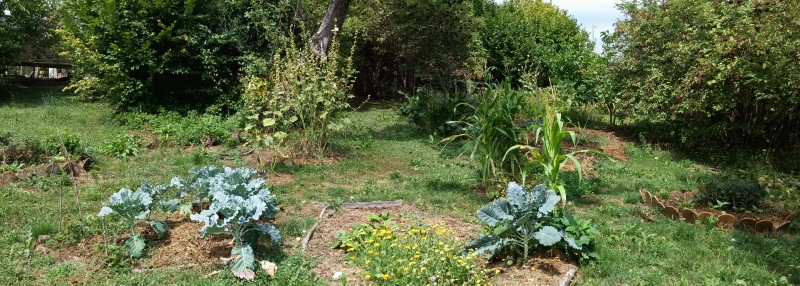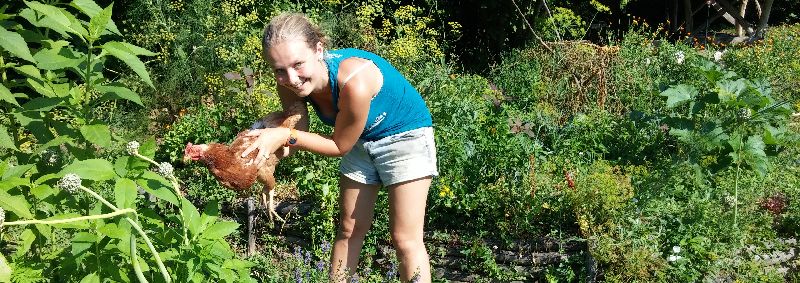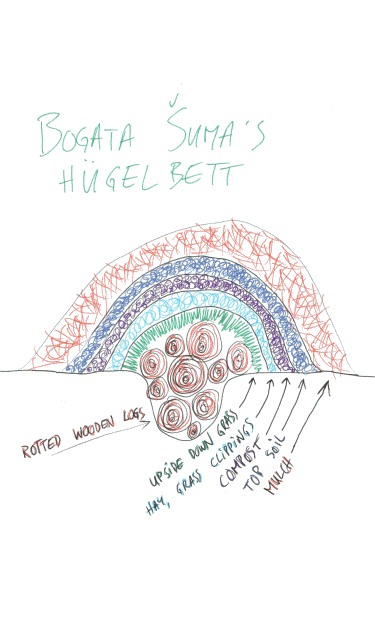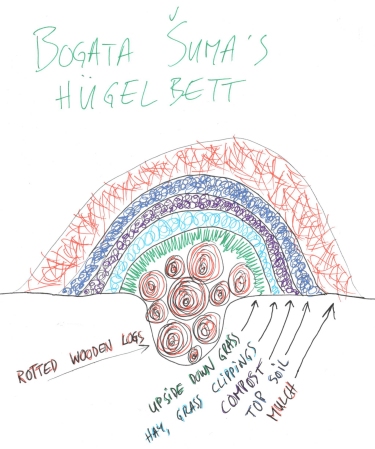 Our ecological vegetable garden is a beautiful, park like area. No rows with more of the same vegetables, but small, usually round beds with a big variety of colorfull vegetable and herb combinations to help each other. Polyculture works for us!
Our ecological vegetable garden is a beautiful, park like area. No rows with more of the same vegetables, but small, usually round beds with a big variety of colorfull vegetable and herb combinations to help each other. Polyculture works for us!
The garden feeds us all year round with various common and uncommon ("forgotten") vegetables. We have special attention for winter vegetables like kale, leek, brussels sprouts, claytonia, winter spinach, fennel, swiss chard and jeruzalem artichoke (with beautifull flowers in fall) to make sure that we get enough winter vitamins.
Of course we grow our own seeds.
 We grow perennial vegetables like asparagus, kale ("eeuwigmoes" in Dutch, which is translated as forever-vegetable), horseradish and rhubarb.
We grow perennial vegetables like asparagus, kale ("eeuwigmoes" in Dutch, which is translated as forever-vegetable), horseradish and rhubarb.
We also have a lot of self seeding vegetables. When the snow melts the claytonia and lambs lettuce come up everywhere, and later in spring also the fennel, coriander, swiss chard, new zealand spinach and nasturtium pop up all around.
What really helps us against snails (besides attracting birds, fireflies and lizards) is the use of copper gardening tools. Copper is not magnetic so it doesn't disrupt the electrical fields in the soil.
They don't rust and can have a good sharp edge, easy to sharpen with a wetstone.
Tiny amounts of copper are good for your plants (nutrients) soil health (micro-organisms) and repel slugs
We also grow a lot of edible flowers (nasturtium, calendula/marigold, borage) between the vegetables to spice up salads and atract even more bees.
We don't dig the garden because we don't like to disturb the soil life. We think it is a shame to destroy the nutrient, water and air systems installed by bugs and fungi, and killing beneficial bacteria by changing their habitat. Therefore it is NOT allowed to step on the soil! The paths are marked (mulched) with wood chips; that is where you can walk.
There is naturally so much air in the soil and the earth established a balance. If you do not turn the soil upside down every year (what also kills a lot of beneficial bacteria), the weeds get less and less.
If there are too many weeds in a bed (because the chickens ate too much chickweed or something), we sheet mulch it with thicker layers of straw or even cardboard.
If the soil is compact, we let potatoes do the digging :-)
One summer we did dig a lot in a new part of the garden. The slope was quite steep so we chose to make terraced garden beds, to prevent water and nutrient runoff. At the same time it made gardening easier because the lower side of the beds were now raised!
>> More about the terraced garden beds

We use the straw from the chickens and rabbits as mulch on the garden beds. The thick layers of mulch (with rabbit shit) protect and feed the soil, and keep it cool and moist.
The garden paths are mulched with wood chips.
We use various composting methods. We have 2 keyhole garden beds (compost in the middle), a kitchen composter, our chickens love to scratch around in compost and twice a year we make a hot compost heap.
Wood (like fallen branches or prunings) go into the branches wall
We add lots of compost and manure to garden beds, we mulch heavily and use herbs and garlic as fertilizers and bug repellents. We use wood ash and a "soup" of garlic, nettle and red hot chili pepper to keep out some bugs, and onion, garlic, mint, dill and other herbs to repel others.
Another, very effective and fun method is hunting with chickens!



Because our air is so clean, lychen grow easy on the tree trunks. Although they don't ask much from the trees, we brush them off once a year.
In winter and early spring we apply a thin layer of the white clay (kaolin) from (deep in) our soil on the fruit tree trunks, to prevent frost damage and reflect the early sunlight. Therefore the trees blossom a bit later (when there's less chance on night frost). The kaolin is also a repellent for bugs.